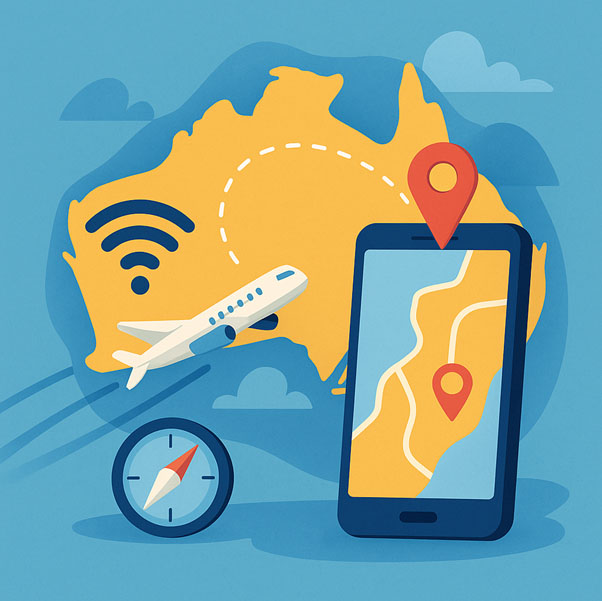Tech-Savvy Travel in Australia: From Navigation to Entertainment
Australia has long been admired for its natural marvels—stunning beaches, immense outback landscapes, and lively cities. Yet behind the postcard-perfect sights, the country is gradually changing into a high-tech travel haven where digital tools enhance every stage of the journey.
Welcome to Australia’s digital playground, where your smartphone is as essential as your sunscreen

Getting Around: Tap, Scan, Go
Australia’s public transportation systems in major cities like Sydney, Melbourne, and Brisbane are seamlessly integrated with contactless payment systems. The Opal and Myki cards now work in tandem with Apple Pay and Google Wallet, allowing travelers to ride ferries, buses, and trains without queuing for tickets.
Need a last-minute ride to a coastal trail? Uber, DiDi, and Bolt operate across urban and semi-rural zones, and scooter-sharing apps like Beam and Neuron are booming in coastal towns.
Even in remote regions, apps like Wikicamps and CamperMate help locate fuel, campsites, and fresh water with offline maps and user reviews. And during long transfers or quiet nights in your accommodation, many travelers unwind with digital entertainment—from audiobooks to casual games or platforms like 7bit casino login, where fun is just a tap away.
Planning Made Simple: From AI Itineraries to Virtual Previews
Gone are the days of guidebooks and print-out maps. Today’s traveler plans their entire trip with a few swipes.
AI-powered travel apps like Rome2Rio and TripIt allow visitors to build intelligent, multi-stop itineraries tailored to personal interests and timeframes. Platforms such as Culture Trip and Google Lens help identify landmarks in real time, offering instant context and reviews.
Meanwhile, virtual reality previews of hotels, hikes, and even snorkeling spots on the Great Barrier Reef let tourists “try before they fly.” This tech not only builds confidence—it creates anticipation.
Staying Connected: Internet, SIM, and VPNs
Whether uploading drone shots from the Daintree or video-calling family from Uluru, staying connected is now a basic travel requirement.
Local SIM cards from Telstra or Optus offer broad coverage, but savvy travelers often pair them with international eSIMs or global data plans. Public Wi-Fi is widely available in libraries, airports, and even some buses.
For full access to international platforms (some of which may be geo-restricted), many visitors install a VPN. It ensures not only security but uninterrupted access to familiar content while abroad—ideal for streaming or gaming during downtime. And for those seeking digital entertainment on the go, platforms like 7bit https://7bit-casino-au.com/ provide quick, mobile-friendly access to a wide range of games, perfect for filling quiet moments while traveling.
Digital Downtime: Smart Entertainment on the Road
After a long day exploring, many travelers turn to digital entertainment to relax—especially when weather or jet lag keeps them indoors.
Some enjoy streaming platforms, others dive into mobile games or puzzles. Increasingly, online platforms offer interactive games with social features—bringing a bit of nightlife indoors.
For those who enjoy a hint of thrill, online casino platforms offer a way to unwind and engage in light entertainment without leaving the hotel. From digital poker tables to themed slot games, these platforms combine chance and fun in a convenient format. One traveler even shared their detailed experience with 7bit casino—a crypto-based platform that caught their attention while traveling abroad.
This tech-based leisure reflects how Australians and visitors alike are blending adventure with comfort—adapting their evenings to fit modern travel habits.
Safety and Navigation: Smart Alerts and Health Tools
Australia’s diverse climate and terrain demand preparation. Fortunately, digital tools make it easier than ever.
Apps like Fires Near Me and Emergency+ keep travelers informed about bushfires, floods, or cyclones in real time. Medical directories provide maps to the nearest hospitals or pharmacies, and COVID-tracking tools remain in place for high-traffic areas.
Tourists with chronic conditions or dietary restrictions use apps to scan product labels or find allergen-friendly restaurants—particularly useful in rural towns with limited offerings.
The Future of Travel Down Under
With expanding 5G coverage, solar-powered charging stations in national parks, and growing use of drone-based delivery systems in isolated regions, Australia is setting the stage for the next generation of travel.
Hotels are experimenting with keyless entry and smart lighting; tour operators are integrating augmented reality for immersive storytelling. The digital frontier is wide open—and Australia is embracing it with both hands.
Conclusion: Embrace the Digital Journey
Australia is more than a destination—it’s an experience shaped by contrast: rugged wilderness and smart cities, timeless nature and cutting-edge tech. Whether you're trekking through rainforests or relaxing in a high-rise hotel, technology travels with you—quietly enhancing every moment.
So, pack your camera, but don’t forget your apps. In 2025, travel in Australia isn’t just about where you go—it’s also about how smartly you get there.
|